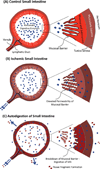The Autodigestion Hypothesis in Shock and Multi-Organ Failure: Degrading Protease Activity
- PMID: 25284955
- PMCID: PMC4180238
The Autodigestion Hypothesis in Shock and Multi-Organ Failure: Degrading Protease Activity
Abstract
Shock and multi-organ failure have one of the highest levels of inflammatory markers, morbidities and mortality. The underlying mechanisms are currently unknown and no effective intervention exists. We present evidence for a previously untested mechanism due to autodigestion by the digestive enzymes synthesized in the pancreas and transported in the lumen of the intestine as normal part of food digestion. We summarize experimental evidence in support of the autodigestion hypothesis and a new approach for possible intervention against multi-organ failure that is currently entering clinical trials.
Keywords: Intestine; chymotrypsin; digestive pancreas; elastase; hemorrhagic shock; inflammation; intestinal mucosa; sepsis; trypsin.
Conflict of interest statement
Figures

Similar articles
-
The autodigestion hypothesis for shock and multi-organ failure.Ann Biomed Eng. 2014 Feb;42(2):405-14. doi: 10.1007/s10439-013-0891-6. Epub 2013 Aug 30. Ann Biomed Eng. 2014. PMID: 23989761 Free PMC article. Review.
-
An elementary analysis of physiologic shock and multi-organ failure: the autodigestion hypothesis.Annu Int Conf IEEE Eng Med Biol Soc. 2012;2012:3114-5. doi: 10.1109/EMBC.2012.6346623. Annu Int Conf IEEE Eng Med Biol Soc. 2012. PMID: 23366584
-
The autodigestion hypothesis: Proteolytic receptor cleavage in rheological and cardiovascular cell dysfunction1.Biorheology. 2016;53(5-6):179-191. doi: 10.3233/BIR-17131. Biorheology. 2016. PMID: 28269737 Free PMC article.
-
Autodigestion: Proteolytic Degradation and Multiple Organ Failure in Shock.Shock. 2016 May;45(5):483-9. doi: 10.1097/SHK.0000000000000544. Shock. 2016. PMID: 26717111 Free PMC article. Review.
-
Pancreatic digestive enzyme blockade in the intestine increases survival after experimental shock.Sci Transl Med. 2013 Jan 23;5(169):169ra11. doi: 10.1126/scitranslmed.3005046. Sci Transl Med. 2013. PMID: 23345609 Free PMC article.
Cited by
-
Challenge to the Intestinal Mucosa During Sepsis.Front Immunol. 2019 Apr 30;10:891. doi: 10.3389/fimmu.2019.00891. eCollection 2019. Front Immunol. 2019. PMID: 31114571 Free PMC article. Review.
References
-
- Ballantyne CM, Nambi V. Markers of inflammation and their clinical significance. Atheroscler Suppl. 2005;6:21–29. - PubMed
-
- Barroso-Aranda J, Schmid-Schönbein GW. Transformation of neutrophils as indicator of irreversibility in hemorrhagic shock. Am. J. Physiol. 1989;257:H846–H852. - PubMed
-
- Barroso-Aranda J, Zweifach BW, Mathison JC, Schmid-Schönbein GW. Neutrophil activation, tumor necrosis factor, and survival after endotoxic and hemorrhagic shock. Journal of Cardiovascular Pharmacology. 1995;25(Suppl 2):S23–S29. - PubMed
-
- Blake GJ, Ridker PM. Novel clinical markers of vascular wall inflammation. Circ Res. 2001;89:763–771. - PubMed
-
- Brierre S, Kumari R, Deboisblanc BP. The endocrine system during sepsis. Am J Med Sci. 2004;328:238–247. - PubMed
Grants and funding
LinkOut - more resources
Full Text Sources
